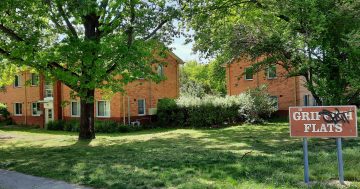
Curtin Residents Association president Ian Elsum says what the government is proposing is not medium density. Photo: Ian Bushnell.
Planning Minister Chris Steel has been accused of misleading the public about future housing at North Curtin by calling it a medium-density development.
Curtin Residents Association president Ian Elsum has also called for the consultation currently underway on how the 13-hectare Territory section of the horse paddocks fronting Yarra Glen should be developed to be paused, saying its dearth of information made it inappropriate.
Mr Elsum said the 1300 homes projected for the site would be the densest residential development Canberra had ever seen.
He said his first calculation of 2.5 residents per dwelling put the area’s population at more than 3000, the size of a new suburb, and density at 25,000 people per square kilometre, more than twice that of New York City as a whole and three times higher than Singapore.
However, the EPSDD’s Jeremy Smith has since said it would be more like Braddon or Kingston, where there are 1.8 residents per dwelling.
Even so, Mr Elsum said this would result in a population of 2340 people and a density of 18,000 people per square kilometre.
“Braddon and Kingston have a density of 5000 people per square kilometre, so we’re 3.5 times denser than Braddon and Kingston,” he said.
“We are now double Singapore. We’re now 60 per cent more dense than central London or New York City.
“This is not a medium-density community; this is a high or very high-density community, and it’s a very large increase in density compared with any other urban development.”
Mr Elsum said residents were not opposed to new housing on the horse paddocks, but with this kind of density, there would be little room for green space unless the buildings were high-rise towers, and the consultation gave little indication about how this new community would work and what roads and facilities would support it.

The 13 ha section of the Curtin horse paddocks where new housing is planned. Photo: ACT Government.
He told Region in August last year, when the government contracted consultancy Communication Link to run the consultation, that there should be 40 per cent green space on the site and building heights limited to three storeys in a genuine medium-density development.
Mr Smith told the ABC that buildings of one to nine storeys were envisaged.
Mr Elsum said Curtin’s concerns were also those of adjacent suburbs, particularly due to traffic impacts on Yarralumla and Deakin.
He said the government believed light rail would solve some of these problems, but the nearest proposed stations were a long way from the horse paddocks, and providing a new one was not a simple project, with the need for raised walkways over Yarra Glen.
Residents were also concerned about education facilities, given Curtin Public School was full and the expanding Garran primary campus could only be reached by car.
Mr Elsum said the identification of the area as a heat island also underlined the importance of green space in any new development.
Planning Minister Chris Steel said the point of this consultation was to hear from the community at the earliest opportunity about the built form, urban and landscape design and design quality before the North Curtin site is released and development occurs.
“We are planning for the development of a well-connected, sustainable, and resilient neighbourhood which provides a choice of housing types to cater for a range of residents’ preferences and needs,” he said.
“Feedback from the community will then be used to help develop the draft Planning Conditions for the North Curtin Residential Area, which will be used to assess future development applications for this site.”
Mr Steel said a future subdivision plan would show roads, utilities, subdivisions of lots and any other approved uses.
“This process will be subject to the National Capital Authority and their approval processes, including further consultation with the community,” he said.
“With Canberra’s population set to grow to 500,000 by 2030 and more than 780,000 people by 2060, the ACT Government is supporting the supply of new homes, particularly focused on areas close to transport and services, as well as investing in the infrastructure to support them.”
The Commonwealth has reserved the rest of the horse paddocks for new embassies.



















